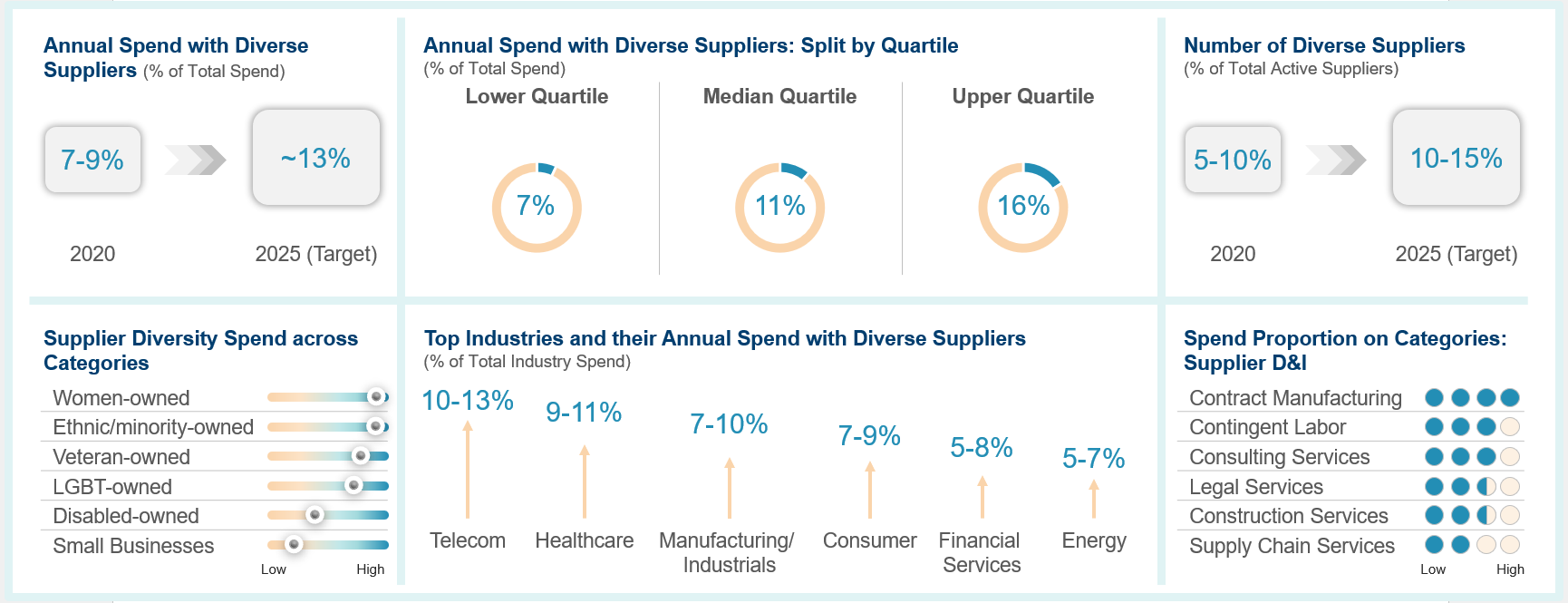Supplier Diversity & Inclusion in the US – A Shift from Need-based to Value-based Approach
Published on 13 Dec, 2021

In recent years, organizations have been driving a ‘real positive' shift in supplier diversity & inclusion (D&I) across the supply chain. Large organizations have been prudently raising their supply diversity targets owing to the inherent value of such initiatives, not out of mere mandatory social compliance. Leading organizations are leaning toward the industry benchmark of 5–13% share of spend on supplier D&I, by primarily targeting the indirect categories. Companies are considering the value-based model over the classical need-based model, primarily due to the long-term benefits such as high ROI (>3.5x), broader network synergies, new business perspectives, and eligibility for tax incentives. They are now taking the adoption of supplier D&I to newer heights by setting aggressive targets.
Diversity of suppliers is key to ensuring sustainability of the supply chain. A procurement business strategy centering on supplier diversity minimizes disruptions in procurement of goods and services and broadens overall network synergies; moreover, it is in line with an organization’s commitment to economic development. Amid increasing benefits and higher ROIs, companies are gravitating toward a value-based approach from need-based while pursuing supplier diversity.
Evolution of Supplier D&I in the US
Supplier Diversity & Inclusion (D&I) has traditionally been a part of social responsibility. It was considered a means to help companies contribute to the society, driven by a push from the government for economic development and focus on CSR activities. Interestingly, the concept has undergone a sea change in recent years.
Companies are realizing the significance of supplier diversity for smooth business operations. After doing an ‘outside-in’ assessment, they are gradually shifting from need-based to value-based model. The benefits are manifold such as high ROI (>3.5x), broader network synergies, eligibility for tax incentives, etc. Considering the effectiveness of the model, large companies now draft formal programs, define goals, implement these, and track progress. Several companies are using supply diversity programs to give effect to social reforms that would have a positive impact. Companies estimate their D&I spend target to increase by >50% by 2025, with an average annual spend target of ~13% dedicated to suppliers across a range of under-represented/minority-owned diversity groups.
This indicates that higher alignment of the supply chain around the value-based approach is bound to yield high returns in the long term.

Preeminent industries and categories for supplier D&I
From an implementation perspective, organizations are actively working toward supplier D&I across industries. However, the scale of procurement spend on diverse businesses serves as the differentiating factor.
Telecommunication and healthcare have been the early adopters, with an overall share of 9–13% of total spend on diverse suppliers. This is primarily due to economies of scale and US federal contractual requirements. The diverse spend is high in telecom as these companies service an infrastructure that spans the length and breadth of the country, allowing them to partner with a broader range of businesses. Healthcare/pharmaceuticals is the second leading segment, as their biggest customer is the federal government, which define contractual requirements requiring working with diverse suppliers. In manufacturing and industrials, spend on supplier D&I is rising and currently stands at 7–10%; it is primarily driven by the automotive and engineering industries which are pioneering supplier diversity initiatives. Consumer, financial services, and energy with 5–9% share of spend are the next in line.
Now that we know the leading industries, it is imperative to deep dive into the categories which are driving supplier D&I adoption. There exist umpteen categories across which the companies generally spread their overall sourcing spend, however the diverse supplier based spend is currently limited to specific categories. Comprehensive analysis of industry spend reveals that the expenditure on diversity is primarily focused on the indirect categories vis-à-vis direct categories. Contract manufacturing, contingent labor, consulting, legal, construction & facility management, supply chain, and R&D & engineering services are the prime D&I spend categories for organizations. Third-party/contractual services such as marketing, equipment/technology, logistics, staffing, and IT services are the emerging categories. In contrast, other categories such as training & development, utility, travel & accommodation, hospitality, subscription & membership-based services are still at a nascent stage with low, yet steady share of spend on diversity.
An organization should, therefore, lean toward the industry benchmark of 5–13% share of expenditure on supplier D&I, by primarily targeting indirect categories.
Best practices for supplier D&I
Leading D&I companies in the US design formal supplier diversity programs, set targets, and explore supplier network synergies. Companies are increasingly focusing on multi-tier diversity reporting in their bid to integrate D&I throughout the supply chain.
Here are some industry-wide best practices which can be followed to get closer to the benchmark spend:
- Design formal programs: Streamline dedicated resources for formal programs to upskill/reskill people for building diverse supplier relationships, and committing to social initiatives
- Define targets: Set definite goals, define concrete targets (for spend, supplier count, etc.), and encourage responsibility and accountability to make the diversity program a success
- Partner with certifying bodies: Join hands with prominent diverse supplier certifying agencies such as WBENC (for woman-owned), NMSDC (for minority-owned), DOBE (for disability-owned), and LGBTE (for LGTBQ-owned) to leverage the benefits of a deeper supplier integration
- Expand network: Expand company’s diverse-owned supplier network by means of external platforms, existing industry network, and associations
- Implement multi-tier reporting: Push sub-tier suppliers to engage with diverse suppliers for facilitating multi-tier diversity reporting and unified commitment across the supply chain
- Shout out 'the commitment': Publish the organization’s commitment toward supplier D&I, and communicate the progress through press releases/newsroom/sustainability reports
Benefits of committing to supplier D&I
Besides the classical benefits, large organizations are exploring the network for newer synergies, perspectives, and dimensions.
Some key benefits of supplier D&I are:
- Increased returns: Formal supplier diversity programs are bound to yield high ROI of >3.5x for every dollar spent on procurement and operating cost.
- New business dimensions: Broadening the diverse supplier spectrum opens-up new channels for opportunities/resources, thereby paving the way for new synergies and perspectives.
- Advancements in innovation: Partnering with diverse-owned businesses brings new dimensions; this drives innovation and creativity; generates opportunities; and increases visibility.
- Dedicated social commitment: Engaging with diverse suppliers helps an organization direct its effort toward economic improvement, job creation, inclusion and making a positive impact.
- Entitlement for tax incentives: Pursuing a supplier diversity program helps in availing of federal/ state incentives, for example, tax breaks on partnering with minority/women-owned diverse businesses, and reduction in tax liability while working on projects that are funded by federal/state grants.
Strategic implications
The evolution of D&I in recent years shows that supplier diversity is the next mandate in supply chain sustainability. Companies that adopt it stand to benefit from new opportunities, while those ignoring the trend risk falling behind.
Leading organizations are increasingly formalizing D&I programs, diversifying their supply chain across major spend categories, tracking progress and openly communicating their achievements. This is proving beneficial to them.
However, the buck does not stop here. Companies must continue to broaden their horizon in terms of achieving supplier diversity by setting aggressive targets. If they wish to stay in the race, this is the time to shift gears in supplier D&I from adopting a need-based approach to pursuing a value-based model.
